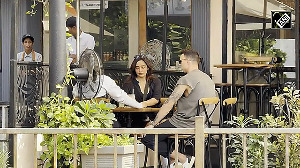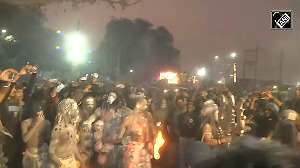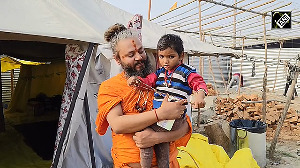Throw away your old camcorders and digital cameras, and replace them with a mobile phone that offers you high-quality video and still-camera facilities. That's last fortnight's message, with both Nokia and Samsung coming out with their latest camera phones.
Indeed, the Nokia's N-90 has been endorsed by none other than ace photographer Raghu Rai whose pictures using the N-90 are better than any that you and I can possibly hope to achieve with even a really top-end camera.
The N-90's part of Nokia's new series of multimedia convergence phone and so, appropriately, looks quite different from the usual Nokia stuff. For one, it's a clamshell and is the first which has two screens, the external one allows you to even shoot photographs without opening the clamshell.
At 173 grams it's a bit bulky, but small enough given the photo-power it packs in. The 2 megapixel camera it has itself gives the N-90 a headstart over most in the field which have 1.3 megapixel cameras (the Sony Ericsson K750i is the exception) -- more important, the lens is a Carl Zeiss one used by most professionals, with an autofocus, zoom and flash.
The main display (when you open the phone) offers a 2.1 inch screen with brilliant colour -- the cover display screen is not as brilliant.
The swivel main display is converted into the viewfinder which makes it very convenient to take pictures or a video. The phone comes with an in-built memory of 31 MB and it comes with a flash card of 64 MB.
Printing or sharing pictures is really easy. You can print directly through the printer (through cable or bluetooth) without a PC interface, provided the printer if compatible with PictBridge software. The picture resolution can also be changed to enable faster email or MMS of the photographs.
The phone is bundled with a starter edition of Adobe Photoshop. The N-90 also allows over two hours of video recording with various on-device editing capabilities and picture richness which is twice as good as most other mobile-phone camera camcorders. You can combine videos, add music, create special effects and virtually turn the video clips into a small movie production.
There are little things which annoy you, however. When the phone is not opened, you can use the cover display screen for only still shots, not video. The flash has a very limited range (around 0.7 metres) and the shutter button and joystick which is on the top end right side of the screen is inconveniently perched (I had to press it hard while taking a picture). On a bright sunny day, the resolution on the screen gets blurred while taking a picture.
At Rs 34,490, the phone is too steeply priced, considering that standalone 4-megapixel digital cameras with Carl Zeiss lenses are available for Rs 11,000, and these can be used for video recording as well.
Canon offers a 3.2 megapixel camera for as low as Rs 8,495. Sony camcorders cost Rs 16,000 and offer unlimited video time given that you can just add a cassette. So, the extra cost for the privilege of having it bundled with a phone is a bit much. In any case, a host of 5 megapixel cameras are on the anvil, so prices should come down considerably soon.
The Samsung E-730, on the other hand, is reasonably priced at Rs 16,449 though the camera is only a 1.3 megapixel one and has an hour of video recording memory. At 88 grams, it's a compact piece and, given the company's expertise in the plasma screen business, the amazing display is par for the course.
The camera comes with a flash, and you can take your own pix using the display on the front cover without opening the phone. The phone also has a good music player and FM which can be operated though the front button on the phone without opening the phone at all.
On camera-mode, users can edit their pictures, add emoticons, frames, and special effects. The phone offers a timer (between 3 seconds to 10 seconds) to take a shot, and you can even take multi-shots of up to 15 in one go at high speeds. You can take your picture in black and white, sepia, emboss or in shades like orange, aqua, or red.
You can adjust the brightness, direction and the distance of the picture or the video on the screen with easy-to-use displays. You can also print pictures through bluetooth and send them though MMS, email and bluetooth -- there is no infra-red connectivity available.
However, the phone does not have a slot to put in flash memory cards so your storage capacity is limited to 90 MB -- if you have 25 songs, the memory's full. Nor does the phone have a USB cable, so the only way to print is through Bluetooth. The battery, my experience showed, drained out after one hour of video shooting plus clicking of some pictures with the flash and listening to some music.
At the price, it looks like value for money, but it's worth checking out the Sony Ericcson K 750i which costs more (Rs 19,995) but offers a 2 megapixel camera, and more memory -- the internal memory is 34MB and the flash is 64 MB, expandable to 2GB.







 © 2025
© 2025